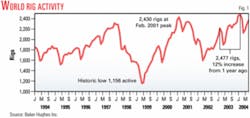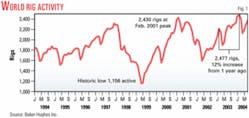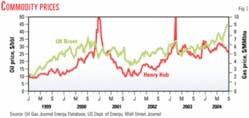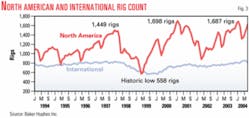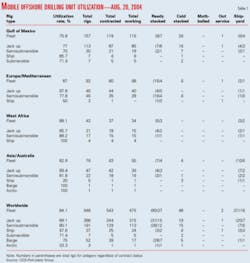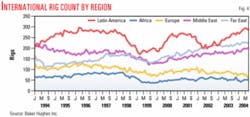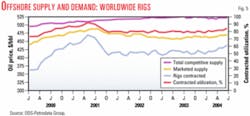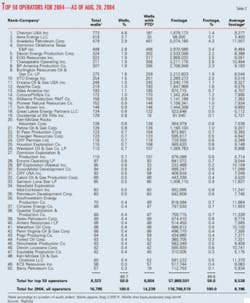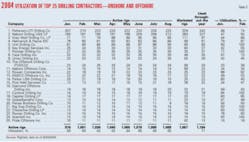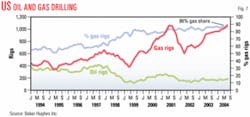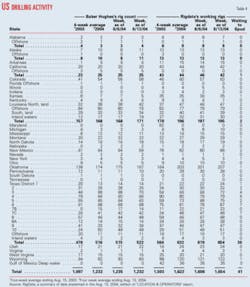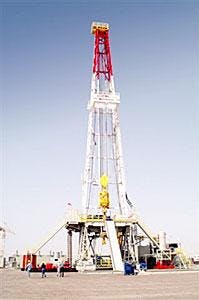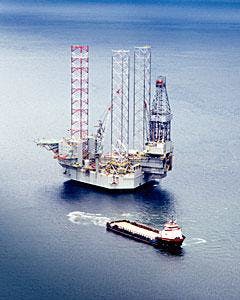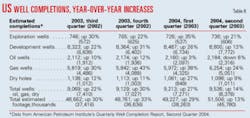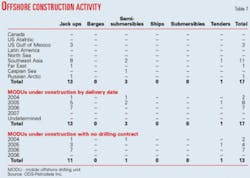The industry is heading into its third year of recovery, and rig utilization is approaching capacity.
Drilling activity in the past year has been higher than the previous 2 years and peaked first-quarter 2004 at 2,477 rigs, more than double the historic low of 1,156 active rigs in 1999 (Fig. 1). The peak represents a 12% increase from a year ago and may still be surpassed in the remaining months of 2004.
Both gas and oil prices continue to rise, driving exploration and development drilling. UK Brent has risen from slightly less than $30/bbl in summer 2003 to $45/bbl in August 2004, and is flirting with $50/bbl at (Fig. 2).
Despite Organization of Petroleum Exporting Countries' 8.5% quota increase in June (2 million bo/d), the largest in 6 years, current prices and crude oil futures continue to rise. High energy prices are problematic because of the threat of curbing economic growth.
Natural gas prices rose from September to December 2003 when Henry Hub spot gas prices peaked first at $6.76/MMbtu and then hit a secondary peak of $6.54/MMbtu the week of May 28, 2004. The price slid to $5.28/MMbtu during the week of Aug. 27 but is certain to rise as winter approaches.
Worldwide activity
Demand for drilling rigs of all types has been increasing in most regions of the world, and new rigs are under construction. Utilization in previously weak areas such as the North Sea and West Africa is improving.
Baker Hughes Inc.'s North American rig counts have been on an upward trend since spring 2002 and reached a peak of 1,687 rigs in January 2004, nearly equaling the historic high of 1,698 rigs in February 2001 (Fig. 3).
The international rig count (excluding North America) reached an historic high of 841 rigs in July 2004, finally surpassing the previous high of 826 active rigs in July 1997. Demand continues upward in almost every region.
As of Aug. 20, utilization rates for jack ups range from 77% in the Gulf of Mexico to 98% in Europe and the Mediterranean (Table 1). Semisubmersible utilization ranges from 70% on the gulf to 88% in West Africa. Drillship utilization ranges from 20% in Asia to 100% in West Africa. Drilling barges and arctic rigs are fully utilized in Asia, although worldwide, only three in four barges and one in three arctic-class rigs were active.
Outside of the US, Latin America has boasted the highest rig counts for the past 10 years, between 250 and 300 in the last year (Fig. 4). The Middle East is the next largest rig user, averaging about 200 in the last year. The Far East is not far behind, increasing to 195 from 175 rigs over the past year. Europe's use has decreased, and Africa's has been steady for the past 3 years.
The worldwide offshore rig supply is about 525 units, and the contracted utilization appears to be at 84% in August (Fig. 5).
The US picture
US rig mobilization has been steeply increasing since fall 2002 and nearly reached 1,200 rigs in August 2004. Rig mobilization tends to parallel, but lag, oil price changes (Fig. 6).
The top 50 US operators drilled 8,323 wells through Aug. 20 of this year, all deeper than 2,500 ft, totaling nearly 58 million ft (Table 2). All operators combined have drilled 16,795 wells in the US in the same period, totaling nearly 117 million ft.
Rig utilization has improved steadily through 2004 for the nation's top 25 drilling contractors, from 59% in January to 65% in August (Table 3).
Patterson-UT Drilling Co. and Nabors Drilling USA LP each had more than 200 rigs working, on average, through the year. Grey Wolf Drilling Co. LP, Helmerich & Payne ICD, and Unit Drilling Co. each had 70-95 rigs working.
Natural gas drilling has dramatically increased relative to oil drilling in the past year due to a burgeoning demand (Fig. 7). Land rig counts in the US approached a 3-year high in August, as Baker Hughes reported 1,069 rigs drilling for gas as of Aug. 27.
Royalty incentives announced by the US Minerals Management Service in January will also contribute to deep shelf drilling (water less than 656 ft; wells deeper than 15,000 ft).
The incentives apply to wells spud on or after Mar. 26, 2003, that start producing within 5 years. Royalties are suspended for the first 15 bcf produced from 15,000 to 18,000 ft, or the first 25 bcf produced from below 18,000 ft.
MMS Director Johnnie Burton said "Since infrastructure and lease-specific facilities are already in place, the OCS is one of the best available sources for additional near-term domestic natural gas supply."
At its Tahiti project in the gulf, ChevronTexaco Corp. plans to construct two subsea drill centers near the two Tahiti appraisal wells that were completed in early 2003 (Green Canyon 596, 640).
Land rig market
The US and Canadian land rig markets are tightening and approaching capacity. Richard Mason, of Land Rig Newsletter, told OGJ that his monthly 1,146 utilization model "shows industry-wide utilization at roughly 85%.
Typically the industry maxes out at 87-88% utilization; so we're at effective capacity. Rig moves, waits on locations, or downtime are reasons utilization tends to max out at this level rather than hit 100%."
Mason said that the fact that rig counts haven't changed a great deal in the last month indicates that "everything capable of working is working."
For the week ending Aug. 27, 2004, the Baker Hughes rig count listed 1,146 land rigs working in the US, while RigData counted 1,619, including rigs working in inland waters (Table 4).
Baker Hughes' statistics perennially undercount activity, as the company does not include rigs as active if they are in transit or rigging up or down, nor does it include "cable tool rigs, very small truck mounted rigs, or rigs that can operate without a permit."
In July, Mason said "Waits on rigs [were]exceeding 45 days in many areas for spot market work" and most US drilling contractors had "the best equipment and crews spoken for through yearend." He also said that rig rates increased about $250-500/day during second quarter, and he expects them to increase $500-1,000/day by fourth-quarter 2004.
For the week ending Aug. 20, 2004, there were 1,362 active land rigs drilling in the US, working on wells deeper than 5,000 ft. Another 109 rigs were drilling wells shallower than 5,000 ft (Table 5).
Land rigs abroad
The land drilling division of KCA Deutag, a subsidiary of Aberdeen's Abbot Group PLC, operates 38 rigs worldwide, including Oman (8 rigs), Libya and Germany (5 rigs each), Nigeria (4 rigs), Pakistan (3 rigs), United Arab Emirates (2 rigs), and in 12 other countries.
In mid-May, the company unveiled a new $9.6-million land rig (Fig. 2). The 3,000-hp T-79 rig has three 1,600-hp mud pumps and was constructed in 9 months at Lamprell Energy Ltd.'s Jebel Ali facility, Dubai. KCA Deutag has two other 3,000-hp rigs, the T-47 and T-51, with EMSCO C-3 III drawworks, currently working in Kazakhstan and Oman.
KCA Deutag will also refurbish two Middle East-based rigs, the T-40 (1,500 hp) and T-80 (2,000 hp), both National 110 M design, currently based in UAE.
Agip Kazakhstan North Caspian Operating Co. awarded design and construction of the "D" Island project to Houston-based National Oilwell Inc., which will include two 3,000-hp harsh environment onshore rigs and drilling support equipment. The total project is valued at $150 million (OGJ, Aug. 9, 2004, p. 9).
An announcement in mid-August said that one of Kazakhstan's largest heavy machinery and equipment manufacturers for the oil and gas industry has built two mobile drilling units for KazMunaiGaz, the Kazakh national oil and gas company.
The Petropavlovsk heavy machine building plant (PZTM AO) in northern Kazakhstan built the rigs with the assistance of Germany's Bentec GmbH, a subsidiary of Abbot Group PLC. About half of each unit was manufactured in Bentec's facility in Bad Bentheim, Lower Saxony, and then completed at PZTM. Rigzone reports that PZTM will deliver three more drilling units to the company later this year, each worth $4.5 million.
PZTM's Deputy Chairman Vladimir Kovshov said, "We are capable of producing them in much bigger quantities, but to do that we need new customers. The Kazakh market is not big enough to make strides; many would rather buy used units because of the low prices. Therefore, we are planning to enter foreign markets."
Offshore rig fleets
Rowan Cos. Inc. announced in June that all 25 offshore rigs were under contract "for the first time in about 6 months," said Chairman and CEO Danny McNease. This includes a $38 million, 11-month North Sea contract for the Gorilla V with Elf Exploration UK PLC, a subsidiary of Total E&P UK PLC.
Rowan has also contracted to drill an ultradeep well on the Gulf of Mexico's Outer Continental Shelf beginning in December 2004 or January 2005, potentially with the new Tarzan-class Scooter Yeargain jack up. The contract is worth $28-35 million, depending on the rig used.
Among the world's four self-erecting semisubmersible drilling tenders, Atwood Oceanic Inc.'s Seahawk comes off a 12-year contract with ExxonMobil E&P Malaysia Inc. Oct.1-15, 2004. Unocal Makassar Ltd. renewed its contract for* Smedvig ASA's West Alliance through first-quarter 2006.
Smedvig announced on Sept. 8 that it hs perchased Statoil's 50% share of the WestNavigator drillship.
The American Bureau of Shipping issued an update of the Guide for Certification of Drilling Systems in January 2004 with the latest comments issued in May (previous version having been issued in 1990).
The guide now provides a risk-based analysis approach to certification. ABS's Merih Unuvar told OGJ that ABS's market share for mobile offshore drilling unit classification was about 72% (547/763) of the worldwide rig fleet in August 2004. Arctic and tender rigs are the most likely to be certified (82%; 27/33), followed by exploration jack ups (7%; 329/428), drillships and drill barges (62%; 75/121), and exploration submersibles and semisubmersibles (58%; 116/201).
Houston-based Parker Drilling Co. announced early August that it sold its Gulf of Mexico rig fleet (31 rigs) for about $40 million. The company retains 43 rigs operating internationally.
GlobalSantaFe's Adriatic IV jack up was lost in August in the Mediterranean, about 60 km off Port Said, Egypt, near the northern entrance to the Suez Canal. The rig was working at the Temsah platform operated by Petrobel, a joint venture of Egypt General Petroleum Co. and AGIP SPA of Italy. The platform caught fire after an explosion and the Adriatic IV sank.
After burning for more than 11 days, Sameh Fahmy, Egypt's minister of petroleum, ordered the Temsah platform destroyed in late August, but the platform was still burning on Sept. 8. EGPC will probably oversee drilling of relief wells using two or three jack ups contracted from GlobalSantaFe and Transocean..
In another Egyptian incident, Transocean's Jim Cunningham semisubmersible suffered a blowout while drilling at West Delta Deep Marine concession Aug. 20. West Delta is operated by BG Group PLC.
US well completions
According to the American Petroleum Institute's 2004 Quarterly Well Completion Report, an estimated 9,536 wells were completed during second-quarter 2004, up 14% from the estimated 8,378 completions in second-quarter 2003 (Table 6).
Exploration wells have increased up to 35% year-over-year, although first-half 2004 saw fewer exploration completions than second-half 2003. Development well completions have increased up to 31% year-over-year and have also increased each of the last 4 quarters, to 8,800 in second quarter 2004 from 8,323 in third-quarter 2003.
Oil well completions increased 1% from first to second quarter this year, but second-quarter completions were down 6% from a year ago. Oil well completions had the slowest year-to-year growth in the 3 preceding quarters, from 3% to 12%.
Gas well completions have increased 24% to 43% year-over-year, in the past 4 quarters, particularly in fourth-quarter 2003. They have also increased progressively in each of the last 4 quarters, to 6,254 in second-quarter 2004 from 5,819 in third-quarter 2003.
US footage drilled has also increased steadily through the last year, to 51,506 ft during second-quarter 2004 from 48,662 ft during third quarter 2003.
Alaskan drilling
Marathon Oil Corp. marks its 50th year of Alaskan activity in 2004. The company designed and built the Glacier Drilling No. 1 truck-mounted mobile rig for Marathon's drilling on the peninsula at Cook Inlet. Between spudding its first well in April 2000 and August 2004, the rig has drilled more than 30 wells, totaling more than 250,000 ft.
According to the MMS, Beaufort Sea Sale 186, held in September 2003, garnered high bids of $8,903,535 for 34 tracts covering 181,000 acres on the Outer Continental Shelf. Beaufort Sea Sale 195 is planned for March 2005; the MMS anticipates posting the Proposed Notice of Sale in October 2004. Beaufort Sea Sale 202 is proposed for 2007.
Beaufort Sea sales began in 1979; 724 leases have been issued following eight sales, and 30 exploration wells have been drilled in the area 3-12 miles offshore. The only production has come from the North Star project, which is primarily in Alaskan state waters, with some down dip wells in the OCS.
Fort Worth's XTO Energy Inc. plans to drill in state waters this year at Cook Inlet. XTO's Shane Alexander told OGJ that the company will drill one or two wells with its top-drive platform rig XTO C.
The last exploration well drilled on the Outer Continental Shelf at Cook Inlet was in 1984. Cook Inlet Oil & Gas Lease Sale 191, scheduled for May 19, 2004, was canceled when no bids were placed. According to MMS Regional Director John Goll, the next sale for federal OCS tracts at Cook Inlet is proposed for 2006.
Alaska receives 27% of all revenues generated by petroleum leasing 3-6 miles off the state coast, with 50% of that going to the Alaska Permanent Fund account.
In early August, ConocoPhillips Alaska (operator, 52%) and BP Exploration (Alaska) Inc. (37%) announced a new, $500 million heavy oil development project on Alaska's North Slope. West Sak is a large, shallow field overlying the ConocoPhillips-operated Kuparuk field. West Sak currently produces about 10,000 bo/d, and this project is designed to increase production to about 45,000 bo/d by 2007.
The partners plan to drill 44 West Sak wells from two drill sites; 13 wells at Drill Site 1E and 31 wells at Drill Site 1J. Each well is expected to produce about 1,500 bo/d initially, due to the use of multilateral wells and enhanced oil recovery technologies, a five-fold increase from wells drilled with older technologies.
Minority partners in West Sak include ExxonMobil (5.8%), Unocal Corp. (5%), and ChevronTexaco (0.1%).
Burlington Resources Inc., in contrast, this July dropped 32 leases it acquired for $1.99 million in the North Slope foothills lease sale in May 2001. The 10-year leases covering 183,000 acres were issued to Burlington's holding company, 5051 Alaska Inc., in July 2002. The leased area remains undrilled.
Southeast Asia
Petronas Carigali Sdn Bhd has drilled and completed Malaysia's longest development well, using extended-reach drilling to reach 80° deviation. The Angsi A-28ST-1 well was spudded in the Angsi oil and gas field offshore peninsular Malaysia on June 29, 2004, and reached 6,339 ms TD on Aug. 11. Petronas Carigali operates the field under a production sharing contract with ExxonMobil Exploration & Production Malaysia Inc. (each with 50% equity interest).
Interoil Corp. and Bontan Oil & Gas Corp., a subsidiary of Toronto-based Bontan Corp., is drilling onshore Papua, New Guinea. The company has drilled the Moose-1, Moose-2, and Sterling-Mustang structures.
Offshore construction
Seventeen offshore rigs are under construction, including 13 jack ups, 3 semisubmersibles, and 1 tender assist rig (Table 7).
Five new-build jack ups are joining the fleets in 2004, with four already completed: Perfadora Central SA de CV's Tonala, Rowan's Scooter Yeargain, Maersk Contractors's XL-2, and GlobalSantaFe Corp.'s Constellation II. ENSCO International Inc.'s 106 will be delivered in December.
According to ODS-Petrodata, five other jack ups are under construction with delivery dates in 2005: Rowan's Bob Keller and Tarzan III, Gazflot OAO gazprom offshore subsidiary Arcticheskaya, National Drilling Co. unnamed No. 1, and ENSCO's 107.
For 2006 delivery, five jack ups are already under construction, and there is an option for the Rowan Tarzan IV. Four are under construction in Singapore: Sinvest ASA's 1 and 2, Odfjell Drilling AS's unnamed No. 1, and Mosbarron Ltd.'s unnamed No.1. The fifth is under construction in China for China Oilfield Services Ltd.
GlobalSantaFe Corp. added two Singapore-built, heavy duty, deepwater jack ups to its fleet in 2003: Constellation I and II. Both are next-generation Friede & Goldman JU 2000 design, capable of working in water as deep as 400 ft. The JU 2000 rig includes an extended reach cantilever, enhanced leg design, and a three-part modular hull. The standard legs are 548 ft long with 36 pinion normal jacking systems.
Constellation I was delivered in July 2003 and contracted through August 2007, currently working off Trinidad. Constellation II is currently working off Argentina.
China Oilfield Services Ltd. (COSL) signed a contract with Houston-based F&G in September 2003 for construction of the Hai Yang Shi You 941 jack up, also based on the F&G JU-2000 design. The COSL rig will incorporate F&G's advanced rack chock operating system (ARCOS) and will be delivered in December 2005. COSL also has an option for construction of a second rig.
GlobalSantaFe has two semisubmersibles under construction, Development Driller I and II. These are F&G ExD design, capable in working in 7,500 ft water. Development Driller I should be ready in March 2005 and Development Driller II in June 2008.
What's ahead
Lehman Bros. analysts believe that exploration and production spending will increase in 2004 by 12% over 2003 levels and see an additional 8-10% increase in 2005. Angeline Sedita said in the Aug. 24 Contract Drilling Weekly that commodity prices are better than expected, drilling rig day rates are slowly increasing, utilization is improving worldwide, and the markets are tightening.
Simmons & Co. International analysts project jack up demand to increase 15-20% by 2007 from 2003 levels. They say jack up utilization will rise above 90% in 2005, and above 95% in 2006-2007.
